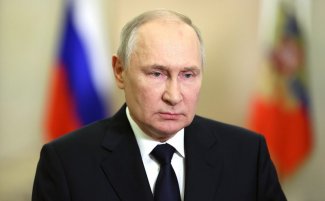The invaders retake the initiative. Day 652 of the war

To the north-west of Bakhmut, Russian forces pushed the defenders out of the last areas they had recaptured during the counter-offensive launched in June. They advanced from there to the outskirts of the village of Bohdanivka, outflanking Chasiv Yar from the north-east. South-west of Bakhmut, the Russians retook control of the hill dominating Klishchiivka; Ukrainian troops had already withdrawn from the northern part of it. The Russians also made slight advances north of Avdiivka and in the outskirts of that town, in the vicinity of the Coke Chemical Combine; they also made progress south of Orikhiv, where they regained some of the territory lost during the Ukrainian counter-offensive in the areas of Robotyne and Verbove. Ukrainian forces counterattacked south of Orikhiv and west of Kreminna, without much success. However, they were able to stop further enemy attacks in Marinka and north-east of Kupyansk; Synkivka is the main focus of the fighting in that area. On the left bank of the Dnieper, the defenders made another attempt to expand their bridgehead at Krynky, successfully blocking Russian attempts to eliminate it. According to a report from the Ukrainian General Staff, the invaders’ activity remains high, at around 90 assaults per day. Compared to previous weeks, the invaders have reduced their pressure on Marinka, and the highest number of attacks is now occurring in the areas of Avdiivka (where 34 enemy assaults were recorded on 6 December), Bakhmut and to the west of Kreminna.
On 8 December the Russians launched their first attack using cruise missiles on Kyiv in 79 days. According to the local military administration, all of them were shot down as they approached the city, but falling shrapnel damaged civilian infrastructure. Dnipropetrovsk oblast was also targeted by Russian missiles, and a few hours earlier by kamikaze drones; it was reported that damage was caused in Pavlohrad (including an industrial plant) and two smaller towns (one person was killed and four injured). Ukrainian Air Force Command spokesman Colonel Yuri Ihnat announced that 14 out of 19 Kh-101/Kh-555 cruise missiles and two out of seven Shahed-136/131 drones had been shot down. In addition, six missiles from S-300 systems struck two areas of Kharkiv; it was reported that civilian facilities had been damaged and two people injured.
On 6 and 7 December, Russian kamikaze drones again attacked the area around Starokostiantyniv in Khmelnytskyi oblast. On 6 December the Russians also used Shaheds in Kirovohrad oblast, from where damage to civilian infrastructure was reported; on 7 December they also struck Odesa oblast, where port facilities in the Izmail area were once again hit. According to summary communiqués from the Ukrainian General Staff, on 6 December the invaders used 50 Shahed-136/131 drones and 21 on 7 December, with the defenders claiming to have shot down 41 and 17 of them respectively. The Russians were also said to have used five missiles of various types on those days, one of which was shot down (the lack of any additional information confirms that Ukrainian military targets outside the built-up area were hit). On 6 and 7 December, the energy ministry and Ukraine’s main energy supplier DTEK also reported the further shelling of heat & power plants in frontline areas (the Ukrainian side has prevented any reporting on the location of the facilities) and the enforced shutdown of some power units. Since the end of October, it has been reported that the enemy shelled heat & power plants in the frontline zone seven times.
On 7 December, the US Navy Command reported that the delivery of VAMPIRE anti-drone systems to Ukraine would be completed in December. It will receive a total of 14 systems; the first four of them were handed over to the army there in the middle of this year. On the same day, Australia’s ambassador to Kyiv Bruce Edwards announced that an additional batch of Bushmaster armoured vehicles had been sent to Ukraine (the number was not specified), and the Polish Armaments Group (PGZ) announced that another batch of Leopard 2A4 tanks used by the defenders had been brought to Gliwice’s Bumar-Łabędy plant for overhaul; the first vehicles of this type were returned to Ukraine in October after being repaired there. Meanwhile, the defence committee of the Bulgarian parliament approved a proposal to hand over inoperable or unnecessary man-portable air-defense system with missiles to Kyiv, on the assumption that Ukraine has the capability to repair them.
On 6 December, a secret meeting was held in Washington between Ukraine’s defence minister Rustem Umierov and the head of the US Defense Department Lloyd Austin. The following day Reuters, citing its own sources, reported that the Ukrainians had presented the Pentagon with a summary of the army’s needs which the United States could meet. It listed armaments which have already been supplied to it (Abrams tanks, 155-mm artillery, ATACMS ballistic missiles and drones) or been promised by the US’s partners (F-16 fighter jets), as well as those not previously requested by Kyiv: these include C-17 Globemaster and C-130 Super Hercules transport aircrafts, F-18 Hornet multi-role combat aircrafts, Apache combat and Black Hawk transport helicopters, MQ-9B Sky Guardian unmanned combat aerial vehicles, and Terminal High Altitude Area Defence (THAAD) anti-ballistic missile systems.
Also on 6 December, the US Department of Defense presented details of a new $175 million military support package for Ukraine. This included AIM-9M and AIM-7 air-to-air missiles for ground-based launchers, HIMARS launcher ammunition, 155-mm and 105-mm artillery shells, HARM anti-radiation missiles, TOW and Javelin anti-tank guided missiles and AT-4 anti-tank grenade launchers, as well as more than 4 million small-arms cartridges. Earlier in the day, Pentagon spokesman Patrick Ryder announced that Washington could still provide $5.9 billion in military support to Kyiv, including $4.8 billion in equipment and war materiel from the US Armed Forces’ resources under the Presidential Drawdown Authority, as well as a further $1.1 billion nominally to replenish the US stockpile, which would also allow for the use of the aforementioned resources. On 7 December, US Security Council spokesman John Kirby stated that unless Congress passed new spending, the US would only be able to guarantee military assistance to Ukraine for a few more weeks.
Reuters reported on 6 December that EU states had so far provided Kyiv with 480,000 artillery shells (mainly 155-mm cartridges and rockets for multiple launch systems) out of the total of 1 million that they had pledged to deliver by spring 2024. Of these 300,000 came from accumulated stocks, 120,000 from individual orders from member states (including purchases from outside the EU) and 60,000 from contracts concluded by the European Defence Agency. At the end of November, the head of Ukrainian diplomacy Dmytro Kuleba reported that Ukraine had received a total of 300,000 artillery shells from the EU.
Also on 6 December, the Ukrainian Centre for National Resistance (CNR) indicated that the Russians are expanding a network of military and sports training centres in the occupied territories. Their activities focus on training young people from the age of 14, with the aim of preparing them for military service. The CNR called this an act of violation of international law by the occupiers, who are recruiting young people to wage war against their own homeland.
On the same day the head of the administration of Sumy oblast, Volodymyr Artiukh, said that Russian artillery shelling had increased over the past two months, and that the activity of enemy sabotage groups made up of 5 to 10 spetsnazsoldiers had increased. They have been conducting constant incursions onto the territory of the region (whose border with the Russian Federation is 560 km long), destroying critical infrastructure facilities and tying up Ukrainian forces. Artiukh admitted that such enemy actions had not been so intense four to five months ago.
Also on 6 December, Illia Kyva, a former Ukrainian politician and pro-Kremlin propagandist who had fled to Russia, was shot dead in Odintsov near Moscow. In November 2023 he had been found guilty of treason and sentenced in absentia to 14 years’ imprisonment and confiscation of property. Kyva’s death was most likely the result of an operation by the Security Service of Ukraine (SBU). On the same day, the SBU set off a bomb in Luhansk, killing a deputy to the so-called Council of the Luhansk People’s Republic, Oleh Popov. This man had previously commanded ‘volunteer battalions’ fighting on the Russian side, and had been responsible for numerous crimes.
On 8 December Ukraine’s ombudsman Dmytro Lubinets stated that the Russian Federation is blocking the exchange of prisoners of war. At the same time, the Russians are contacting relatives of both imprisoned civilians and POWs, claiming that it is the Ukrainian government which does not want to carry out the exchanges. This is intended to provoke social and political tensions.
On 7 December, Ukraine’s National Agency for Prevention of Corruption (NAPC) launched an open database containing information on more than 2000 foreign components used in military equipment produced by Russia and Iran (including drones, missiles, electronic warfare systems). They say this will allow them to investigate supply chains and find those who are circumventing the sanctions. The database is available at sanctions.nazk.gov.ua/military-components.
Commentary
- The war has once again entered a phase in which the invaders have the advantage. After gradually regaining the initiative in the tactical dimension since September, the Russians have also moved onto the front foot operationally and strategically. This manifests itself not only in their sustained, increased activity in most directions in recent weeks and their slow but systematic displacement of the defenders from their positions, but also in the activation of sabotage and reconnaissance groups in the north-east of Ukraine.
- The problems observed in 2022, especially those caused by poor logistics, are not currently visible in the Russian operations. However, the solidification and expansion of the invaders’ potential is not the decisive factor. The most significant reasons for the Ukrainian army’s shift to the defensive are the reduction in military support from the West and the war fatigue experienced by both the soldiers (some units have not been rotated for over a year) and the general population; this translates into a progressive decline in Ukraine’s capabilities for mobilisation. However, both these factors are independent of each other. Meanwhile, the reduction in Western support may exacerbate the negative trends on the Ukrainian side, which were almost certainly catalysed by the failure of the summer counter-offensive.





